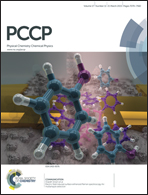New insights into the ideal adsorbed solution theory†
Abstract
The GCMC technique is used for simulation of adsorption of CO2–CH4, CO2–N2 and CH4–N2 mixtures (at 298 K) on six porous carbon models. Next we formulate a new condition of the IAS concept application, showing that our simulated data obey this condition. Calculated deviations between IAS predictions and simulation results increase with the rise in pressure as in the real experiment. For the weakly adsorbed mixture component the deviation from IAS predictions is higher, especially when its content in the gas mixture is low, and this is in agreement with the experimental data. Calculated activity coefficients have similar plots to deviations between IAS and simulations, moreover obtained from simulated data activity coefficients are similar qualitatively as well as quantitatively to experimental data. Since the physical interpretation of activity coefficients is completely lacking we show for the first time that they can be described by the formulas derived from the expression for Gex for the ternary mixture. Finally we also for the first time show the linear relationship between the chemical potentials of nonideal and ideal solutions and the reduced temperature of interacting mixture components, and it is proved that the deviation from ideality is larger if adsorption occurs in a more microporous system.


 Please wait while we load your content...
Please wait while we load your content...